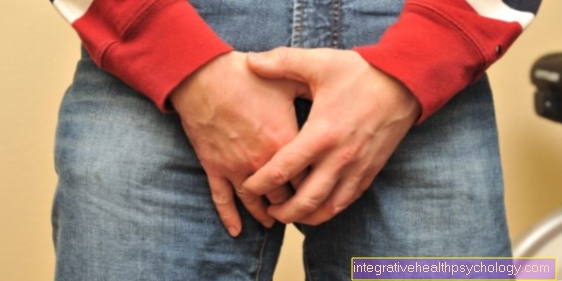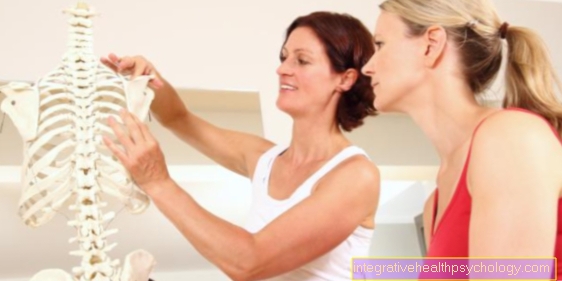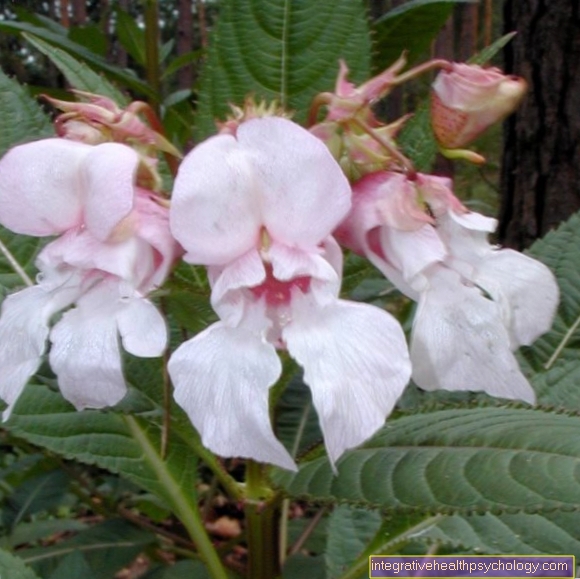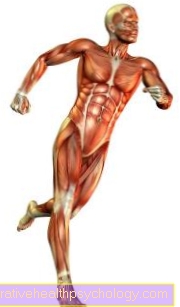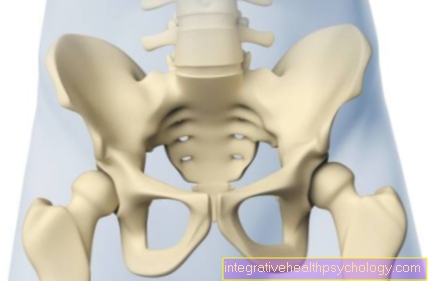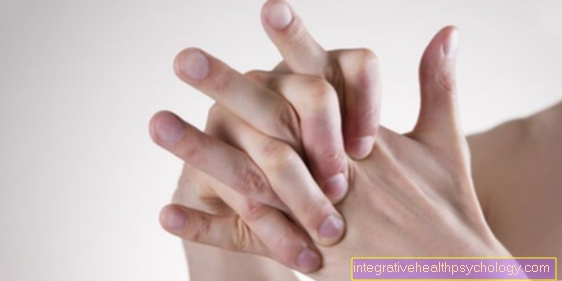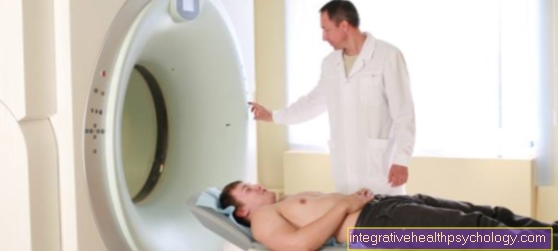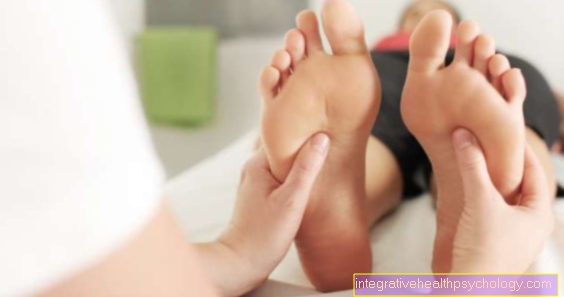Drop hand
definition
Drop hand is a disease in which the active movement of the wrist and finger joints towards the back of the hand, i.e. the lifting of the hand and stretching of the fingers, is impaired by damage to the radial nerve. The most common causes of radial palsy (technical term for damage to the radial nerve) are fractures of the upper arm or dislocation of the shoulder.

Causes of a falling hand
The cause of the drop hand is damage to the radial nerve. In a healthy state, this nerve conveys the impulses from the brain to the muscles that are responsible for lifting the hands. The most common injury mechanisms that can damage the radial nerve and thus lead to a drop hand are fractures in the upper arm shaft and shoulder dislocations. The fact that the nerve is particularly likely to be affected by fractures of the upper arm shaft is simply due to the fact that it runs particularly close to the bone in this area, as well as in the shoulder area.
For this reason, other circumstances associated with a pressure load on the upper arm should also be named as possible triggers for a drop hand. This includes, for example, lying on the side or on the arm for long periods of time or the long-term use of crutches, which exert pressure in the upper arm or shoulder area. A special case is the so-called “park bench paralysis”: Here, after sitting on a bench for a long time with arms stretched backwards and wrapped around the bench, pressure is also placed on the inside of the upper arm and thus also on the radial nerve. In contrast to a fracture of the upper arm or shoulder dislocation, there is usually no structural damage to the nerve, so that in this case the drop hand usually disappears by itself within a relatively short time. Other, rarer causes can be nerve inflammation or tumors that displace the radial nerve.
after drinking alcohol
Drop hand symptoms occur surprisingly often after drinking alcohol. However, to conclude that the alcohol damaged the nerve is wrong. Rather, it can be assumed that the affected person slept so deeply after excessive alcohol consumption that he barely moved during sleep and therefore lay on the affected arm for a long time. In a sober state, this would have become uncomfortable over time and he would have moved in his sleep. The hand dropped after alcohol consumption is to be assessed in terms of therapy and healing like the park bench paralysis described above. There is no major structural nerve damage, so that improvement usually occurs within a few days and full restoration of functionality within a few weeks. Occupational and physiotherapeutic exercises can accelerate the healing process.
Upper arm fracture
A broken upper arm is the most common cause of a dropped hand. This connection arises from the anatomical circumstances. In the area of the upper arm shaft, i.e. in the middle area of the humerus, the radial nerve runs in the immediate vicinity of the bone. If this breaks, which usually happens as a result of a fall on the arm, the nerve can be damaged by bone fragments or be trapped in the fracture gap. A drop hand results. It can also lead to a restriction in elbow extension and numbness on the back of the hand. The closer to the shoulder the fracture of the upper arm is, the greater the risk.
Shoulder dislocation
A shoulder dislocation, i.e. a dislocation of the shoulder joint, is usually the result of an accident in which the person concerned falls on the outstretched arm. One of the most common side effects of shoulder dislocation is damage to the radial nerve with the resulting hand drop. If the joint head jumps out of the joint socket in the event of a shoulder dislocation, it also tears at the neighboring radial nerve and can cause damage. Since the radial nerve has not yet given off any nerve branches to any muscles or skin areas before it passes through the shoulder joint, damage as a result of a shoulder dislocation will impair all muscles for which the nerve is responsible. In addition to the hand and finger extensors, the failure of which causes the hand to fall, this also includes the triceps muscle, so that extension in the elbow joint is no longer possible. In addition, there is numbness or even a complete loss of feeling on the back of the hand, the back of the forearm and parts of the upper arm.
diagnosis
If the hand is dropped, the doctor will first determine the extent of the impairment using functional tests. For this purpose, it is checked whether there is still a residual ability to stretch the hand and fingers and whether the muscle reflexes can still be triggered. The doctor will then examine whether there are any further functional restrictions. The focus is on the investigation of elbow extensibility and skin sensitivity on the back of the hand and the back of the forearm. In this way, the doctor can already assess where the damage is and how severe it is. The doctor can also draw important conclusions about a possible cause or the course of the accident from the patient's reports.
Based on this, a so-called electromyography can then be carried out in case of doubt. With the help of surface or needle electrodes, it is examined to what extent the impulses of the radial nerve still reach the muscles responsible for hand and finger extension. From this, the extent and prognosis of the nerve damage can be estimated relatively precisely. An alternative is to measure the nerve conduction velocity (NLG) using electroneurography.
Nerve conduction velocity
The nerve conduction velocity (NLG) of a nerve describes the speed with which a nerve can convey its information. It is often reduced when the nerve is damaged. If the nerve is completely severed, it is obvious that no more information can be passed on, so that the NLG drops to 0.
In the case of a drop hand, the measurement of the NLG can be considered if the diagnosis or the extent of the nerve damage is still unclear after anamnesis and functional tests. To do this, two electrodes are first placed on the, one in front of and one behind the suspected damage site. A pulse is then emitted via the first electrode and the time it takes for the pulse to reach the second electrode is then measured. The comparison with normal values then allows the conclusion whether there is damage in the examined nerve area and, if so, how severe it is.
You can read more about this procedure on our page on this topic: Electroneurography
Concomitant symptoms
Since the most common causes of a dropped hand are a shoulder dislocation and an upper arm fracture, there is of course considerable pain in the shoulder and upper arm in these cases. In addition, nerve damage in the shoulder and upper arm area impaired elbow extension and numbness in parts of the back of the hand and the back of the forearm. In the case of damage to the middle to lower arm, on the other hand, there are usually no accompanying symptoms apart from possible pain.
Pain
The drop hand itself or the responsible damage to the radial nerve usually does not cause pain. Some sufferers only report somewhat unpleasant sensations in the skin areas supplied by the nerve, i.e. on the back of the hand and the back of the forearm. Since the nerve damage is in most cases the result of an upper arm fracture or shoulder dislocation, the hand drop can of course be accompanied by considerable pain in the upper arm or shoulder. If the patient is able to localize this pain, this is the first important step in setting the course for diagnostic and therapeutic measures.
deafness
If the drop hand results from nerve damage close to the shoulder - as can be the case with a shoulder dislocation or a fracture of the upper arm close to the shoulder - it can also lead to numbness or even a complete loss of sensation in certain areas of the skin. The latter includes the half of the back of the hand facing the thumb, the central back of the forearm and a small area on the lower side of the upper arm.
Which muscles are affected in a drop hand?
The drop hand results from the damaged nerve that conveys the “movement commands” to the hand and finger extensors. These muscles are each referred to as the extensor muscle (extensor = extensor), whereby the name of the body part that it is extending is added as the third part of the name. Correspondingly, there is an extensor indicis muscle (extensor finger), an extensor digiti minimi muscle (extensor finger), an inside and an outside extensor carpi muscle (wrist extensor), a wide and a long extensor pollicis muscle ( Thumb extensor) as well as an extensor digitorum muscle (extensor of all fingers except the thumb).
In addition to these finger and hand extensors, the radial nerve also supplies the supinator and brachioradialis muscles, which primarily rotate the forearm outwards. It follows that a drop hand can sometimes be accompanied by an inward twist of the forearm.
In addition, the abductor pollicis longus muscle, which is responsible for spreading the thumb, is under the control of the radial nerve. And finally, the triceps brachii muscle ("triceps") receives its impulses from the radial nerve, which is why damage to the nerve in the shoulder area often manifests itself in a paralysis of the elbow extension in addition to the hand drop.
therapy
If the nerve is completely severed, surgical reconstruction must be carried out. A special suture technique, the nerve suture, is used. If the nerve is severed and severely damaged, an autogenous nerve transplant may be necessary: a less important nerve is removed from another part of the patient's body and used to bridge the damaged part of the radial nerve.
In the case of damage without severing, the conservative approach, i.e. without surgery, can usually be used. It is essential to protect the arm so that the nerve gets the necessary rest for regeneration. A (plaster) splint can be applied for this purpose. Anti-inflammatory drugs such as ibuprofen or paracetamol are supposed to prevent the development of an inflammatory reaction. In certain circumstances the injection of cortisone preparations into the damaged area can be considered. Immediately initiated physiotherapy and / or occupational therapy is very important for a quick and complete recovery of functionality.
If the nerve cannot be replaced with a transplant, certain surgical restructuring of the hand muscles and tendons can be performed. For example, the tendons of muscles that are actually responsible for flexing the wrist are shifted to the back of the hand. In these cases, the physiotherapy and occupational therapy aftercare is particularly important, as the patient has to learn that a different muscle than before is now responsible for the extension.
Occupational and physiotherapy
Physiotherapy is an essential aspect of the treatment of a drop hand. In the case of an operation, physiotherapy should be started in the first few days after the operation. At the beginning it is mainly important to move the arm out of the rail. Otherwise tendons in particular could otherwise scar together with the surrounding tissue during the period of immobilization, which would lead to a permanent restriction of mobility that is difficult to correct. Since immobilization is important for nerve recovery, but also atrophies the muscles, the focus of physiotherapy after removing the splint is on restoring muscle strength.
Occupational therapy is mainly used when the hand drop has been treated by surgical reconstruction of the hand tendons. The patient must therefore now learn to use other muscles if he wants to stretch his hand. To do this, occupational therapists use various exercise techniques that train the coordination between the brain, nerves and muscles.
Which track can help?
There are different rails that can be used. What they usually have in common is that they keep the wrist slightly extended to make it easier to raise the hand. However, when choosing a suitable splint, individual anatomical conditions must be taken into account, as well as the extent of the hand drop symptoms and the question of whether an operation was performed.Occupational therapists and physiotherapists often have particularly good knowledge and experience with regard to the choice of splint, which is why it is advisable to consult an appropriate therapist before a possible operation. On this occasion, appointments for the treatment after the operation can be arranged directly.
Which exercises can help?
In general, all exercises that train the hand and fingers can help. In the first few days, lifting without resistance will be more or less difficult for most patients. If a certain training effect has set in, resistance can also be used, such as weights that are hung around the hand or fingers, making the exercise more difficult.
Let your occupational therapist or physiotherapist demonstrate the exact exercise sequences. It should be emphasized that you should also repeat the exercises learned there regularly at home, as otherwise a noticeable effect can hardly be achieved. If you are unsure about how to perform the exercises, do not hesitate to ask the therapist again so that no ineffective or even harmful movements become established. In addition, the therapists often have other tricks that can accelerate the regeneration of functions, e.g. the setting of ice stimuli to improve the sensation that may also be impaired.
Duration
The time it takes to achieve full or extensive recovery depends heavily on the cause and extent of the damage.
If there is a fracture of the upper arm or a shoulder dislocation, the healing time is extended simply by the fact that the bone or ligament injury requires immobilization for several weeks. It is true that occupational and physiotherapeutic exercises to improve the drop hand symptoms can already be started during this phase, but only to a much lesser extent.
If, on the other hand, there is only a drop hand without bone or ligament injuries, such as e.g. in the case of "park bench paralysis", intensive hand exercises can be started immediately after the diagnosis. In this case, too, a splint is usually made, but it is usually more flexible and can possibly also be removed to perform the exercises. In this way, the first therapeutic successes are usually achieved within a few days and functionality is usually completely restored after a few weeks.
In the case of an operative nerve suturing or transplantation, the nerve fibers naturally have to grow back together first. This can take a few weeks, so you shouldn't be discouraged if you don't see any immediate improvement in the first few days after surgery.
forecast
The falling hand usually has a good prognosis, even if this depends, of course, on the cause and extent of the damage.
"Park bench paralysis" as a result of chronic pressure on the nerves usually improves on its own within a few days to weeks, whereby physiotherapy and occupational therapy exercises can accelerate the process.
If, on the other hand, a surgical intervention is necessary, the healing process is extended. Nevertheless, in most cases, a complete restoration of the hand and finger functions can be achieved after a few weeks to a few months.
The completeness and speed of the healing is strongly dependent on the discipline with which the immobilization and exercise of the affected hand are followed!


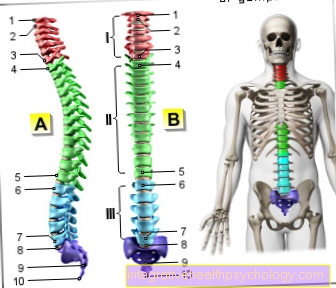

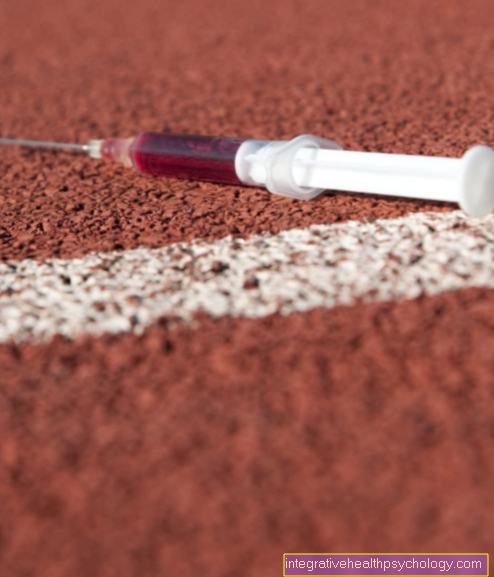


.jpg)
